Where a Customer-Focused Culture Starts
Culture isn’t something you promote. It’s something you embody. So, it must start in the C-suite--and put down that smartphone.

Culture isn’t something you promote. It’s something you embody. So, it must start in the C-suite--and put down that smartphone.

Get Involved
Our authors are what set Insurance Thought Leadership apart.
|
Partner with us
We’d love to talk to you about how we can improve your marketing ROI.
|
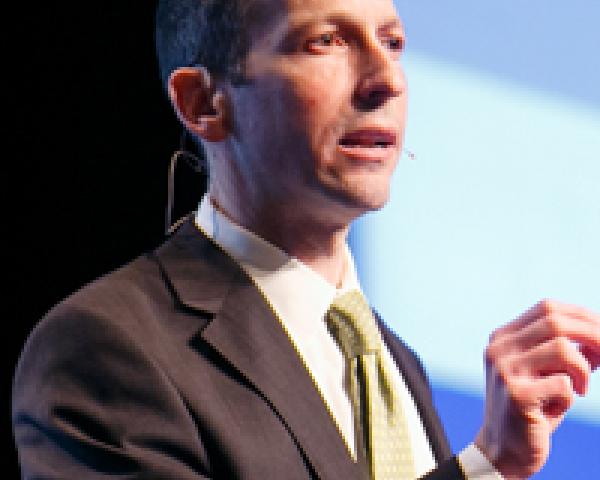
Jon Picoult is the founder of Watermark Consulting, a customer experience advisory firm specializing in the financial services industry. Picoult has worked with thousands of executives, helping some of the world's foremost brands capitalize on the power of loyalty -- both in the marketplace and in the workplace.
Restaurants need to take three steps to deal with all-too-common sexual harassment of staff by customers--and to avoid lawsuits.

Get Involved
Our authors are what set Insurance Thought Leadership apart.
|
Partner with us
We’d love to talk to you about how we can improve your marketing ROI.
|

Jordan Markuson is a member of the hospitality practice and insurance broker at Heffernan Insurance Brokers. He specializes in reducing worker’s compensation and liability premium of restaurants groups through alternative risk, safety and risk management programs.
Smart employers are taking steps to help their people make good decisions and become better stewards of their savings and retirement accounts.

Here are the themes I am seeing most often in health and welfare benefits:
Theme: Financial Wellness – Americans are struggling to get ahead, and the middle class is declining. Successful retirement and wealth planning for many people is a simple act of good accounting decisions multiplied over many years. Instant gratification has eroded good decision-making, and large majorities of people have no savings or retirement funds. Smart employers are taking steps to help their people make good decisions and become better stewards. This encapsulates retirement strategy, education, student loan assistance, emergency loan assistance and the like.
Sub-Theme: Student Loan Repayments – Extremely hot benefit right now; it’s one of the most requested benefits by new employees.
Theme: Dependent Care – People are living longer, and in sub-optimal health. Huge portions of the workforce are now having to spend large quantities of time managing the health and care of their dependents and loved ones. Smart employers are looking for ways to relieve this burden and improve the productivity of the workforce.
See also: Dissecting Landmark Decision on WellnessTheme: Hospital Department Quality vs. Physician Quality – More and more data is becoming available regarding hospital and doctor quality scores. How do we think about it? How is it used? Which firms are stepping forward to help people access quality? If I contract directly with a hospital, am I hurting patient access to the highest-quality providers who aren’t with that hospital? These questions are important and could be addressed with the right sessions.
Theme: Member Steering and Plan Strategy – The best plans are seeking new and improved strategies to steer members. As more cost and quality data becomes available, proper healthcare procurement begins to depend on the firm's ability to steer members. A few firms are leading the way to get exceptional procurement and steerage, and most employers could learn much from them to save millions and get control of (arguably) the hardest budget item in the firm.
Theme: The Care-Knowledge Gap – There is a devastating time period between when a therapy is discovered and when the therapy is available in most major hospitals. This gap has grown to 17 years; thus, the healthcare of 2035 is available today if you can find it. Smart employers and activist entities are working hard to reduce this wait time to save lives and accelerate the improvement of American healthcare.
Theme: Augmented Primary Care – Primary care has had a rough decade. At worst, it has been vanishing, and, at best, it has been acquired and used as a referral source for hospital systems. Smart employers realize that, for them to get control of their spending, they need to partner with primary care doctors whose interests are aligned with the employer and the member. This interest is to keep members healthy by consuming the minimum effective quantity of healthcare services, from professionals operating at the top of their respective licenses, in settings offering the best value. Direct primary care represents the best approach to achieve this objective, and building appropriate technology into these settings can significantly reduce the dependence on the greater hospital system.
See also: Wellness Works? Prove It–and Win $$$Themes Losing Steam: These topics appear (to me) to be losing their luster very quickly:
Get Involved
Our authors are what set Insurance Thought Leadership apart.
|
Partner with us
We’d love to talk to you about how we can improve your marketing ROI.
|

Brian Klepper is principal of Healthcare Performance, principal of Worksite Health Advisors and a nationally prominent healthcare analyst and commentator. He is a former CEO of the National Business Coalition on Health (NBCH), an association representing about 5,000 employers and unions and some 35 million people.
Healthcare payers and providers are discovering the value of sharing vast amounts of data -- but this must be just the beginning.

Get Involved
Our authors are what set Insurance Thought Leadership apart.
|
Partner with us
We’d love to talk to you about how we can improve your marketing ROI.
|
As innovation work matures in corporations, leadership is now initiated more and more in business units and less and less in IT.

Get Involved
Our authors are what set Insurance Thought Leadership apart.
|
Partner with us
We’d love to talk to you about how we can improve your marketing ROI.
|

Deb Smallwood, the founder of Strategy Meets Action, is highly respected throughout the insurance industry for strategic thinking, thought-provoking research and advisory skills. Insurers and solution providers turn to Smallwood for insight and guidance on business and IT linkage, IT strategy, IT architecture and e-business.
The current low-yield environment raises questions about retirement savings and inequality. Insurance can help solve the problem.

Get Involved
Our authors are what set Insurance Thought Leadership apart.
|
Partner with us
We’d love to talk to you about how we can improve your marketing ROI.
|

Dr. Christian Hott is an independent economic advisor based in Dannau near Hamburg, Germany. He has over 15 years experience in conducting original research, writing reports and holding lectures in the areas of economic development, financial stability and the regulation of the financial sector.
The great news is that every fix to healthcare's structural problems has been invented -- and you can massively scale them.

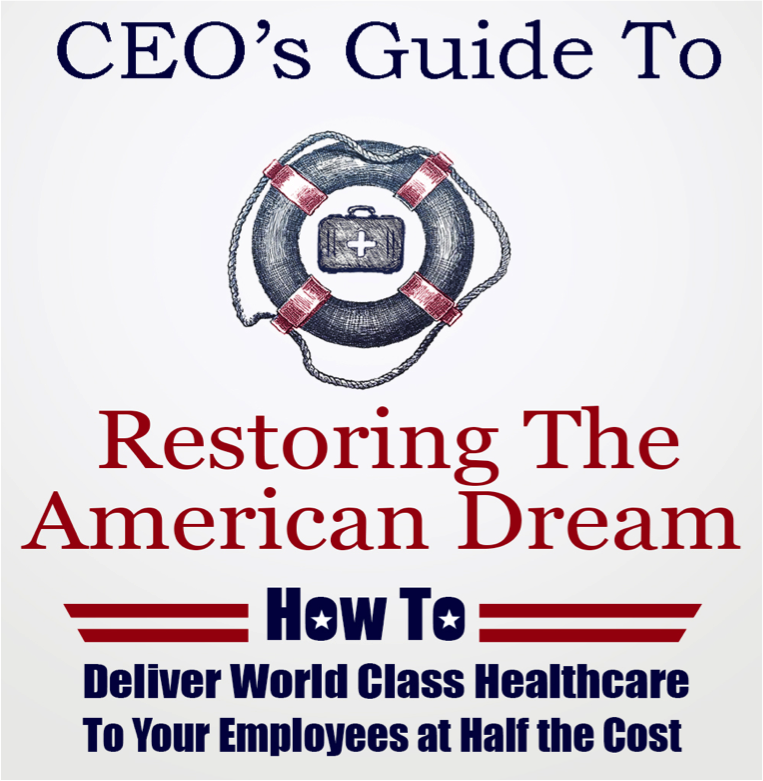 My book can be found on Amazon or downloaded for free.
My book can be found on Amazon or downloaded for free.
Get Involved
Our authors are what set Insurance Thought Leadership apart.
|
Partner with us
We’d love to talk to you about how we can improve your marketing ROI.
|

Dave has a unique blend of HealthIT and consumer Internet leadership experience that is well suited to the bridging the gap between Health IT systems and individuals receiving care. Besides his role as CEO of Avado, he is a regular contributor to Reuters, TechCrunch, Forbes, Huffington Post, Washington Post, KevinMD and others.
Everything was riding on a contrarian theory: that Lemonade’s newness and uniqueness would make it more trustworthy, not less.

 But as the hours turned to days, and days to weeks, questions remained. A full year’s worth of data now offers some answers, and what follows are the highlights, and lowlights, of 2017.
1. “Nobody will trust a company called ‘Lemonade’!”
A major early question was whether a newborn company, with a juvenile name, could engender the necessary trust. Everything was riding on our contrarian theory: that Lemonade’s newness and uniqueness would make it more trustworthy, not less.
You see, traditional insurers often equate trustworthiness with financial strength, which they project by erecting monumental buildings that dominate the skyline.
But as the hours turned to days, and days to weeks, questions remained. A full year’s worth of data now offers some answers, and what follows are the highlights, and lowlights, of 2017.
1. “Nobody will trust a company called ‘Lemonade’!”
A major early question was whether a newborn company, with a juvenile name, could engender the necessary trust. Everything was riding on our contrarian theory: that Lemonade’s newness and uniqueness would make it more trustworthy, not less.
You see, traditional insurers often equate trustworthiness with financial strength, which they project by erecting monumental buildings that dominate the skyline.
 Skyscrapers weren’t within our budget, but in any event we believed such extravagance sends the wrong signal. People worry their insurer lacks the will to pay, not the means. So we established Lemonade as a public benefit corporation, with a view to signaling something very different. We hoped today’s consumers would find our approach refreshing and trustworthy.
The data suggest that they have.
Skyscrapers weren’t within our budget, but in any event we believed such extravagance sends the wrong signal. People worry their insurer lacks the will to pay, not the means. So we established Lemonade as a public benefit corporation, with a view to signaling something very different. We hoped today’s consumers would find our approach refreshing and trustworthy.
The data suggest that they have.
Since Jan 1. 2017, Lemonade insured more than 100,000 homes, with our members entrusting us to insure them against more than $15 billion of losses.See also: Lemonade’s Latest Chronicle Our total sales for 2017 topped $10 million, with ~5% of our sales materializing in the first quarter, and more than 50% in the fourth. This means our sales are on a strong and exponential growth curve.
 On launch day, we thought of our team as pioneers and true believers. But after our first year, we know it is our community of more than 100,000 who deserve those accolades. It is they who entrusted billions to a brand new insurer, and it is that trust that is powering the change.
Which brings us to the second thing we now know. We know our customers.
2. “Being the cheapest attracts customers — but the wrong customers”
The boogeyman in insurance is adverse selection. As an insurer, you set your price based on what a customer should cost you on average. But if, instead of attracting average customers, you attract the kind who switch frequently, or claim excessively, you’re selling at a loss, and your days are numbered. Adverse selection is a particular threat to price leaders.
On launch day, we thought of our team as pioneers and true believers. But after our first year, we know it is our community of more than 100,000 who deserve those accolades. It is they who entrusted billions to a brand new insurer, and it is that trust that is powering the change.
Which brings us to the second thing we now know. We know our customers.
2. “Being the cheapest attracts customers — but the wrong customers”
The boogeyman in insurance is adverse selection. As an insurer, you set your price based on what a customer should cost you on average. But if, instead of attracting average customers, you attract the kind who switch frequently, or claim excessively, you’re selling at a loss, and your days are numbered. Adverse selection is a particular threat to price leaders.
 And we were determined to be a price leader.
But while we designed our business for value, we also designed it for values – and it was important to us that our customers appreciate both. Value alone selects adversely, but values select advantageously.
We breathed a sigh of relief when customers tweeted about Lemonade’s low prices a lot, but about its B-Corp and Giveback even more. The tweeting was an encouraging early data point.
And we were determined to be a price leader.
But while we designed our business for value, we also designed it for values – and it was important to us that our customers appreciate both. Value alone selects adversely, but values select advantageously.
We breathed a sigh of relief when customers tweeted about Lemonade’s low prices a lot, but about its B-Corp and Giveback even more. The tweeting was an encouraging early data point.
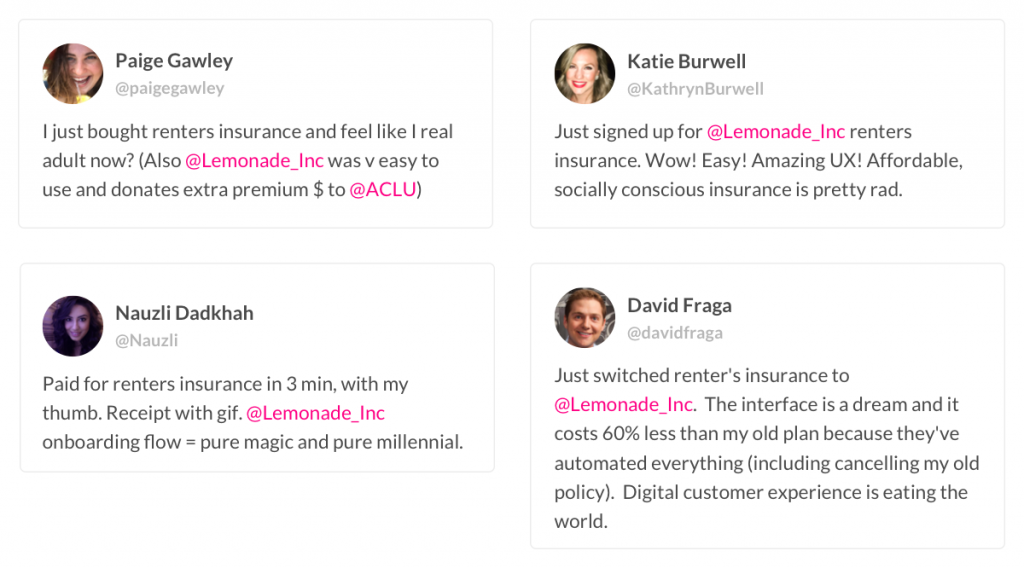 As more data came in during the course of the year, our assessment of the adverse selection threat became more rigorous. See, throughout the many decades, the insurance industry has learned that people’s education and job are highly predictive of what kind of risk they represent. If Lemonade’s customers were below average by these measures, we’d have a problem, no matter what our Twitter feed said.
Good news: They are not.
The stats on Lemonade customers (who, by the way, are 50:50 male and female) suggest our members are more than 100% over-indexed for both graduate degrees and really high-paying jobs. All this notwithstanding the fact that 75% of our members are under the age of 35!
The upshot: Lemonade is attracting the next generation of outstanding insurance customers.
3. “Making claims easy will lead to a flood of claims”
It’s an open secret in the insurance industry that a painful claims process discourages claims. There’s only so many times you can hear that "your call is important to us and will be answered in the order in which it was received," before you say "to hell with it" and give up on your claim.
Instant claims? That could unleash a torrent of frivolous claims.
As more data came in during the course of the year, our assessment of the adverse selection threat became more rigorous. See, throughout the many decades, the insurance industry has learned that people’s education and job are highly predictive of what kind of risk they represent. If Lemonade’s customers were below average by these measures, we’d have a problem, no matter what our Twitter feed said.
Good news: They are not.
The stats on Lemonade customers (who, by the way, are 50:50 male and female) suggest our members are more than 100% over-indexed for both graduate degrees and really high-paying jobs. All this notwithstanding the fact that 75% of our members are under the age of 35!
The upshot: Lemonade is attracting the next generation of outstanding insurance customers.
3. “Making claims easy will lead to a flood of claims”
It’s an open secret in the insurance industry that a painful claims process discourages claims. There’s only so many times you can hear that "your call is important to us and will be answered in the order in which it was received," before you say "to hell with it" and give up on your claim.
Instant claims? That could unleash a torrent of frivolous claims.
 Truth be told, things were hairy for a while. Early in 2017, a couple of large claims arrived in rapid succession. We only had a few customers at that time, and as a proportion of our revenue (known as a "loss ratio") these few claims were daunting. Statistics taught us to expect this kind of lumpiness in the early days, but we still slept fitfully until our business grew and our loss ratio began to normalize. We were in a much healthier place by year’s end (we report our 2017 loss ratio to regulators next month), and the frequency of claims is in line with our modeling.
Truth be told, things were hairy for a while. Early in 2017, a couple of large claims arrived in rapid succession. We only had a few customers at that time, and as a proportion of our revenue (known as a "loss ratio") these few claims were daunting. Statistics taught us to expect this kind of lumpiness in the early days, but we still slept fitfully until our business grew and our loss ratio began to normalize. We were in a much healthier place by year’s end (we report our 2017 loss ratio to regulators next month), and the frequency of claims is in line with our modeling.
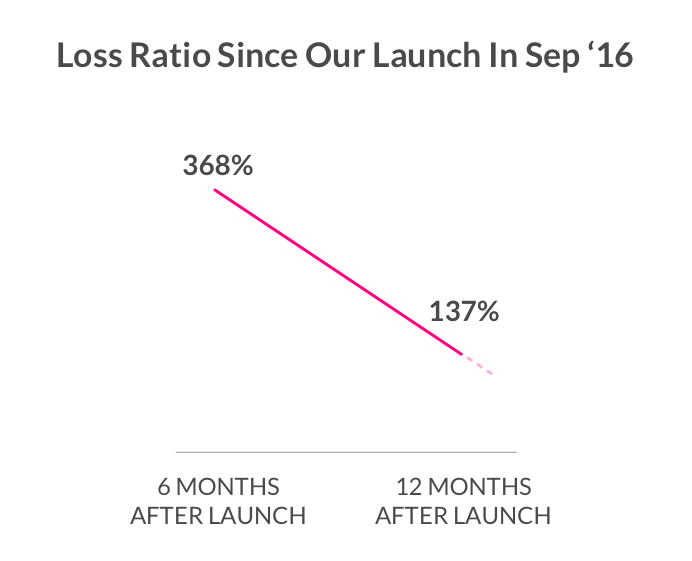 Beyond the noisiness that is a byproduct of small numbers, our system seemed to have improved as we fed it more data. For example, our loss ratio among policies sold in 2016 is more than 2X that of policies sold in 2017. This suggests that our underwriting was pretty shoddy in our early days. Definitely a lowlight.
Since then, we’ve taught our systems to be far more careful when underwriting policies, and our bot Maya declined to quote more than $17 million of business in 2017. This has markedly improved the underlying health of our business – but there’s still a ways to go. Early mistakes will continue to drag down our reported loss ratio for awhile.
Our knight in shining armor? That’d have to be our claims bot, Jim. When we announced his ability to review, approve and pay a claim in seconds, we surprised a few. Happy to report that, during 2017, AI Jim grew his capacity to pay claims 40X.
[caption id="attachment_30120" align="alignnone" width="570"]
Beyond the noisiness that is a byproduct of small numbers, our system seemed to have improved as we fed it more data. For example, our loss ratio among policies sold in 2016 is more than 2X that of policies sold in 2017. This suggests that our underwriting was pretty shoddy in our early days. Definitely a lowlight.
Since then, we’ve taught our systems to be far more careful when underwriting policies, and our bot Maya declined to quote more than $17 million of business in 2017. This has markedly improved the underlying health of our business – but there’s still a ways to go. Early mistakes will continue to drag down our reported loss ratio for awhile.
Our knight in shining armor? That’d have to be our claims bot, Jim. When we announced his ability to review, approve and pay a claim in seconds, we surprised a few. Happy to report that, during 2017, AI Jim grew his capacity to pay claims 40X.
[caption id="attachment_30120" align="alignnone" width="570"] See also: Lemonade’s New Push: Zero Everything [/caption]
Our algorithms are getting better at flagging attempts at fraud, and we reported several of these to the authorities. Yet overall the data shows that honesty is rampant among our members, and what behavioral economists dub reciprocity is alive and well: About 5% of our customers contact us, after their claim is paid, to say their stuff turned up and they want to return the money. Our team has centuries of combined experience in insurance, but this was a first for them all!
See also: Lemonade’s New Push: Zero Everything [/caption]
Our algorithms are getting better at flagging attempts at fraud, and we reported several of these to the authorities. Yet overall the data shows that honesty is rampant among our members, and what behavioral economists dub reciprocity is alive and well: About 5% of our customers contact us, after their claim is paid, to say their stuff turned up and they want to return the money. Our team has centuries of combined experience in insurance, but this was a first for them all!
 A quick look at the instant claims suggests our members spend a lot of time on phones and bikes. But this year had all kinds of losses: big ones like fires and smaller ones like stolen headphones.
A quick look at the instant claims suggests our members spend a lot of time on phones and bikes. But this year had all kinds of losses: big ones like fires and smaller ones like stolen headphones.
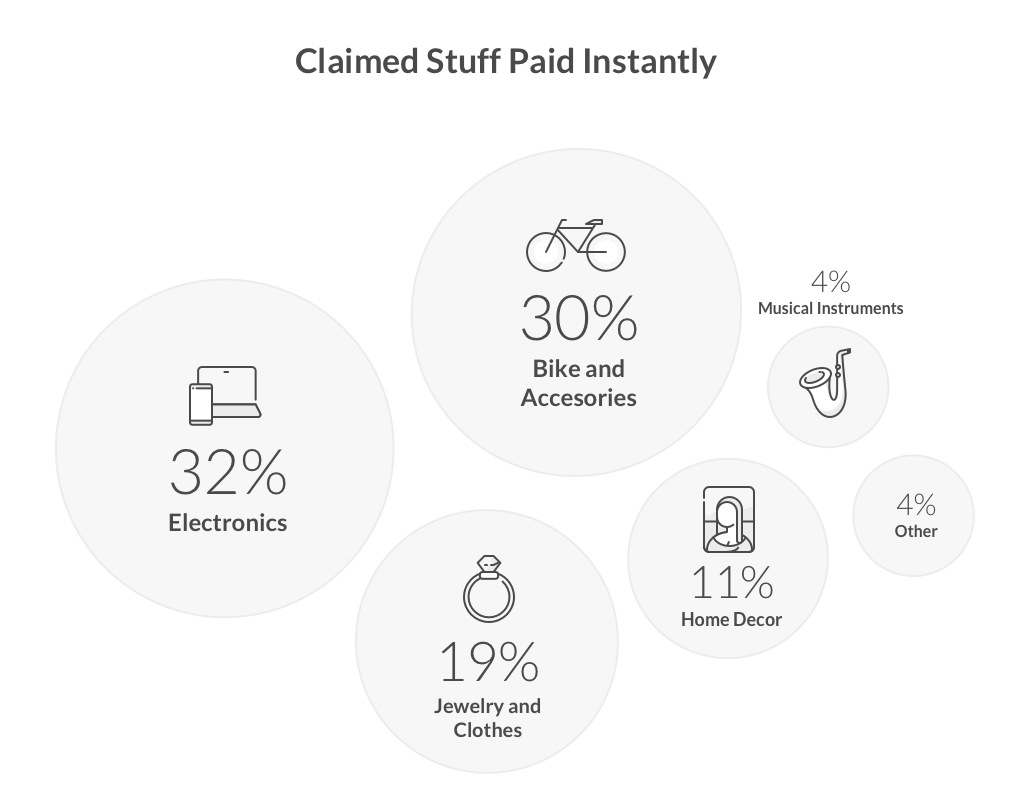 We are proud to say that we were (and are!) there for our community in times of need.
[caption id="attachment_30123" align="alignnone" width="570"]
We are proud to say that we were (and are!) there for our community in times of need.
[caption id="attachment_30123" align="alignnone" width="570"]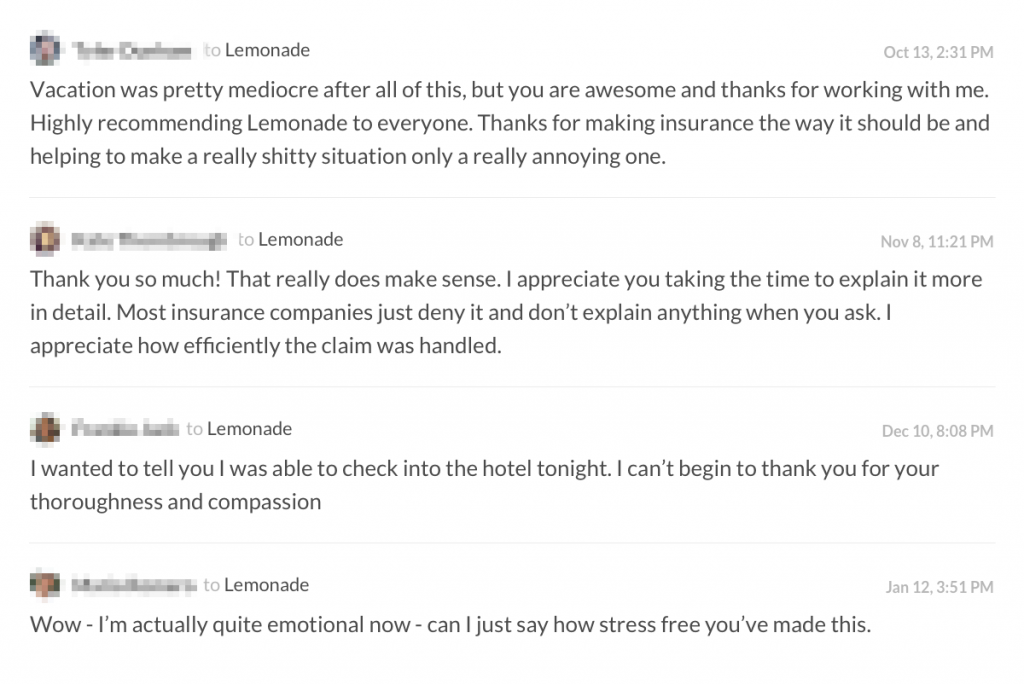 Positive reviews of Lemonade's instant claims[/caption]
Stopping to smell the roses
2017 wasn’t all roses. We saw shockingly high loss ratios in the first half of the year, some vicious responses to our stand on guns and knock-off attempts by some of the Goliaths of the industry.
At the same time, we saw tremendous adoption by our customers, exciting advances in our tech, licenses from 25 states and a Giveback that amounted to 10% of our revenues.
We’re extremely grateful to our team, our customers and our regulators for making 2017 all that it could be. No doubt 2018 won’t be all roses, either, but we will stop to smell them whenever we can. ?
Positive reviews of Lemonade's instant claims[/caption]
Stopping to smell the roses
2017 wasn’t all roses. We saw shockingly high loss ratios in the first half of the year, some vicious responses to our stand on guns and knock-off attempts by some of the Goliaths of the industry.
At the same time, we saw tremendous adoption by our customers, exciting advances in our tech, licenses from 25 states and a Giveback that amounted to 10% of our revenues.
We’re extremely grateful to our team, our customers and our regulators for making 2017 all that it could be. No doubt 2018 won’t be all roses, either, but we will stop to smell them whenever we can. ?
Get Involved
Our authors are what set Insurance Thought Leadership apart.
|
Partner with us
We’d love to talk to you about how we can improve your marketing ROI.
|

Daniel Schreiber is CEO and co-founder at Lemonade, a licensed insurance carrier offering homeowners and renters insurance powered by artificial intelligence and behavioral economics. By replacing brokers and bureaucracy with bots and machine learning, Lemonade promises zero paperwork and instant everything.
Distracted driving has major negative implications for insurers and society. But this is not the only type of distraction that can cause problems.

One important trend in society over the past decade is our increasing ability to create and consume a seemingly unlimited amount of digital content. Whether the content is for information, entertainment or commerce, the result is that most people are staring at screens of various sizes and swiping, typing, pinching, voice-commanding or interacting with the content in some other way. The services and our ability to communicate and conduct business has had a major impact on society in general, affecting virtually every segment of our world. While there are many good and positive outcomes emanating from the digital world, there are also negative consequences. One of those is the increase in what I call distracted living.
See also: Distracted Driving: a Job for Insurtech?Distracted driving, a well-known phenomenon, has major negative implications for insurers and society. The “need” to send text messages, participate in phone calls, do web searches and interact with the vehicles navigation/entertainment system all take attention away from driving. Insurers are painfully aware of this problem, as it has caused a spike in accidents in recent years. But this is not the only type of distraction that can cause problems. Examples of distracted living that can be just as harmful or even dangerous include:
These are but a few examples of how the easy availability of digital content takes our attention away from important activities. Although many of these are insignificant from an actuarial standpoint for insurers (besides distracted driving), distracted living is still a cause for concern and a trend that the industry should continue to monitor.
Get Involved
Our authors are what set Insurance Thought Leadership apart.
|
Partner with us
We’d love to talk to you about how we can improve your marketing ROI.
|

Mark Breading is a partner at Strategy Meets Action, a Resource Pro company that helps insurers develop and validate their IT strategies and plans, better understand how their investments measure up in today's highly competitive environment and gain clarity on solution options and vendor selection.
Mergers and acquisitions in the second half of 2017 ended on a strong note, and activity should see further acceleration in 2018.

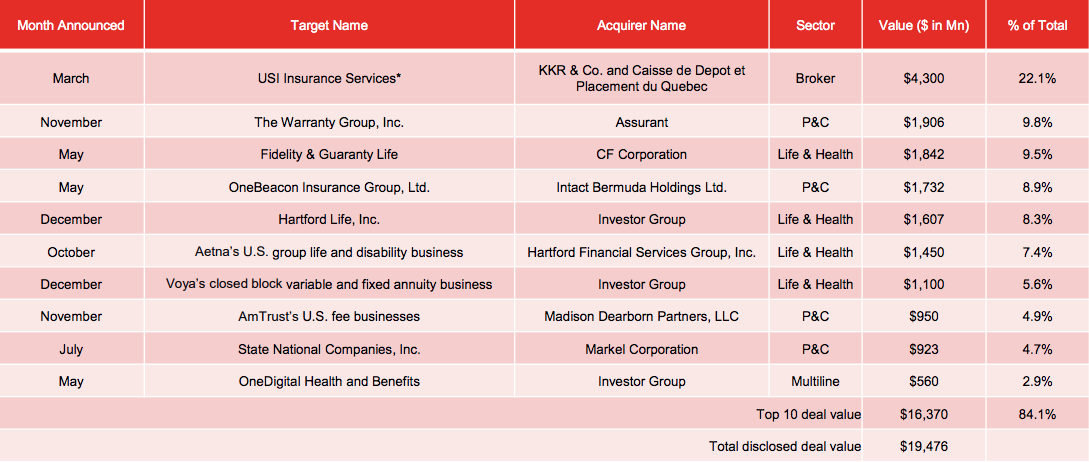 Source: S&P Global Market Intelligence[/caption]
Sub-sector highlights and outlook
Source: S&P Global Market Intelligence[/caption]
Sub-sector highlights and outlook
Get Involved
Our authors are what set Insurance Thought Leadership apart.
|
Partner with us
We’d love to talk to you about how we can improve your marketing ROI.
|

John Marra is a transaction services partner at PwC, dedicated to the insurance industry, with more than 20 years of experience. Marra's focus has included advising both financial and strategic buyers in conjunction with mergers and acquisitions.